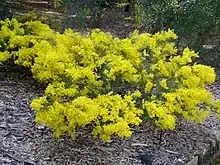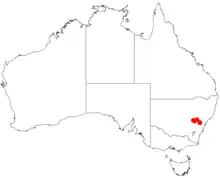Acacia meiantha
Acacia meiantha is a species of flowering plant in the family Fabaceae and the subgenus Phyllodineae that is endemic to a small area in eastern Australia. It was listed as Endangered in 2018 according to the Environment Protection and Biodiversity Conservation Act 1999.[1]
| Acacia meiantha | |
|---|---|
 | |
| Scientific classification | |
| Kingdom: | Plantae |
| Clade: | Tracheophytes |
| Clade: | Angiosperms |
| Clade: | Eudicots |
| Clade: | Rosids |
| Order: | Fabales |
| Family: | Fabaceae |
| Subfamily: | Caesalpinioideae |
| Clade: | Mimosoid clade |
| Genus: | Acacia |
| Species: | A. meiantha |
| Binomial name | |
| Acacia meiantha Tindale & Hersc. | |
 | |
| Occurrence data from AVH | |
Description
The shrub has an erect or sometimes straggling habit and can grow to a height of around 1.5 to 2.5 m (4 ft 11 in to 8 ft 2 in) and often spreads by suckering. It has smooth greenish brown to grey or light brown coloured bark and angled hairy branchlets. Like most species of Acacia it has phyllodes rather than true leaves. The crowded, glabrous and evergreen phyllodes are straight to slightly curved, with a length of 1 to 6.5 cm (0.39 to 2.56 in) and a width of 0.4 to 1 mm (0.016 to 0.039 in) and have an indistinct midvein. It blooms between July and October producing yellow flowers. The simple inflorescences are found in groups of 2 to 19 in an axillary raceme. The spherical flower-heads have a diameter of 3 to 5 mm (0.12 to 0.20 in) and contain four to eight yellow to dark yellow coloured flowers. Following flowering firmly papery to thinly leathery glabrous seed pods form. The straight or slightly curved pods are more or less flat and straight sided or constricted a little between each of the seeds. the pods are around 2.7 to 8.5 cm (1.1 to 3.3 in) in length and 4 to 7 mm (0.16 to 0.28 in) wide.[2]
Taxonomy
The species was first formally described by the botanists Mary Tindale and C.Herscovich in 1992 as part of the work Acacia meiantha (Fabaceae, Mimosoideae), a new species from the Central Tablelands of New South Wales as published in the journal Australian Systematic Botany. It was reclassified as Racosperma meianthum by Leslie Pedley in 2003 then transferred back to genus Acacia in 2006.[3] The latin specific epithet of meiantha is derived from the few flowers contained in the flower-heads. The phyllodes resemble those of Acacia linifolia and Acacia boormanii.[2]
Distribution
It has a limited range from around Clarence and Mullions Range in the Great Dividing Range in New South Wales where it is found among dry sclerophyll forest or woodland communities growing in clay or sandy soil.[2] The area of its range is estimated to be 68 km2 (26 sq mi) consisting of severely fragmented populations that are in decline. There are three disjunct populations located on the Central Tablelands situated within 100 km (62 mi) of one another.[4]
See also
References
- "Acacia meiantha". Species Profile and Threats Database. Department of Agriculture, Water and the Environment. Retrieved 8 July 2020.
- "Acacia meiantha Tindale & Herscovitch". PlantNet. Royal Botanic Garden, Sydney. Retrieved 8 July 2020.
- "Acacia meiantha Tindale & Herscovitch". Atlas of Living Australia. Global Biodiversity Information Facility. Retrieved 8 July 2020.
- "Conservation Advice Acacia meiantha" (PDF). Summary Assessment. Threatened species scientific committee. Retrieved 8 July 2020.
